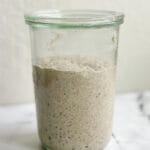How to create a Sourdough Starter
A good starter is the foundation of incredible bread! These simple steps will give you a great starter in as little as 7 days.
- Prep Time: 7 days
- Total Time: 168 hours
- Yield: 90g starter
Ingredients
- whole rye flour
- unbleached all-purpose flour
- water, filtered
Instructions
- Day One: To a clean jar, add 100g whole rye flour and 125g warm water (about 95°F). Stir until fully combined and there are no dry bits. Loosely cover and let sit for 24 hours.
- Day Two: To a clean jar, add 75g of the mixture from Day One, 50g whole rye flour, 50g unbleached all-purpose flour and 115g water (room temperature). Stir until fully combined. Loosely cover and let sit for 24 hours. (Discard the remaining mixture from Day One)
- Day Three: To a clean jar, add 75g of the mixture from Day Two, 50g whole rye flour, 50g unbleached all-purpose flour and 115g water (room temperature). Stir until fully combined. Loosely cover and let sit for 24 hours. (Discard the remaining mixture from Day Two)
- Day Four: You will feed the starter twice. This is easiest if you do one in the morning and one in the evening. To a clean jar, add 75g of the mixture from Day Three, 50g whole rye flour, 50g unbleached all-purpose flour and 115g water (room temperature). Stir until fully combined. Loosely cover and let sit for 12 hours. (Discard the remaining mixture) After 12 hours, repeat the same steps for a second feeding and let mixture sit for 12 hours.
- Days Five & Six: Repeat steps of Day Four, feeding every 12 hours.
- Day Seven and Beyond: In the morning of Day Seven, in a clean jar, combine 10g of the mixture, 10g whole rye flour, 30g unbleached all-purpose flour and 40g water. (Discard the rest of the mixture from the previous feeding). Repeat this feeding twice a day, about 12 hours apart indefinitely. You can maintain your starter with just about any type of flour you like from this point.
Notes
- Recipe updated 1/29/24. I originally had listed a 1:2:2 ratio for maintenance, but have since found that a higher ratio like 1:4:4 ratio is generally safer and will not peak too soon within the 12 hour feeding time. Adjust your ratios as needed for your own kitchen conditions. See post for more tips.
- After you have a well-established starter, that rises dependably every 12 hours, you can switch flour types. Different flours will behave differently and change the flavor of your bread. Keep in mind that whole grains tend to encourage a very active starter.
- If you want to maintain a smaller starter, decrease each ingredient by the same ratios.
- If you do not use your starter fairly frequently and don’t want to have to maintain it twice a day, you can store it in the refrigerator and feed once a week. When ready to bake, give it two feedings, each 12 hours apart and use after it has risen to its peak.
- The best types of water to use are bottled, spring or purified filtered water. Using tap water may inhibit the health of your starter as it typically contains chemicals like chloramine which can kill the good bacterias in your starter.
Find it online: https://thatbreadlady.com/how-to-create-a-sourdough-starter/
